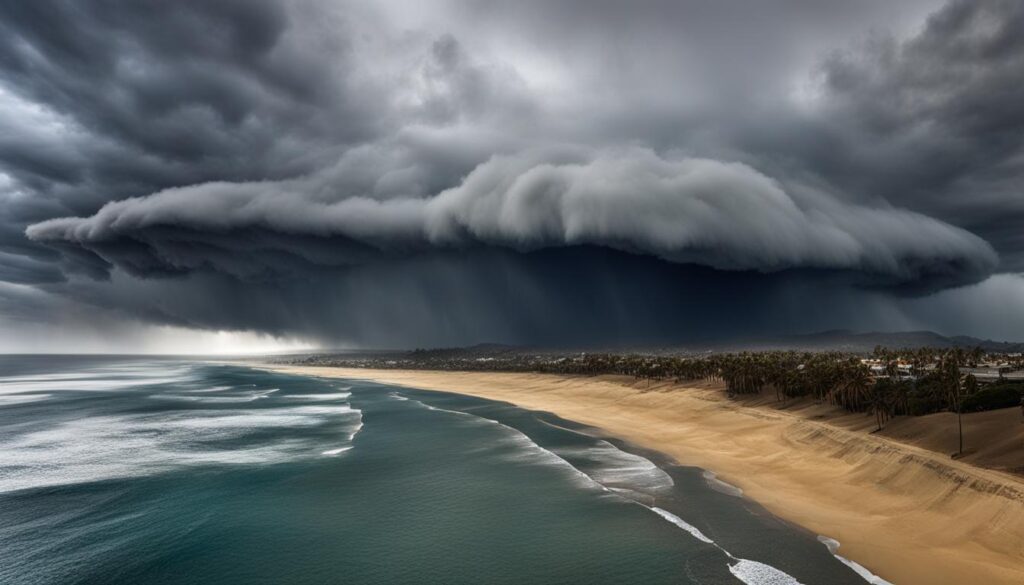El Niño and La Niña are opposite phases of the El Niño/Southern Oscillation (ENSO) cycle, which involves variations in sea-surface temperatures, rainfall, air pressure, and atmospheric circulation in the equatorial Pacific Ocean. El Niño refers to above-average sea-surface temperatures, while La Niña refers to below-average sea-surface temperatures. These weather phenomena occur naturally due to interactions between the ocean surface and the atmosphere, affecting global weather patterns.
- El Niño and La Niña are opposite phases of the ENSO cycle.
- El Niño involves above-average sea-surface temperatures, while La Niña involves below-average sea-surface temperatures.
- These weather phenomena occur due to interactions between the ocean surface and the atmosphere in the equatorial Pacific Ocean.
- El Niño and La Niña impact global weather patterns.
- Understanding the differences between these phenomena helps predict and prepare for associated weather impacts.
El Niño Effects
El Niño is a weather phenomenon characterized by warmer than normal tropical Pacific sea surface temperatures. It has significant impacts on weather patterns globally, affecting various regions in different ways. One notable effect of El Niño is the shifting of the Pacific jet stream, causing dryer and warmer conditions in the northern United States and Canada. Conversely, the U.S. Gulf Coast and Southeast experience increased rainfall, leading to an elevated risk of flooding.
Marine life off the Pacific coast is also affected by El Niño. Weakened or absent upwelling, which brings nutrient-rich waters to the surface, leads to a reduction in nutrients and changes in fish distributions. This disruption in the marine ecosystem can have cascading effects on fishing industries and coastal communities that rely on a healthy ocean ecosystem.
“El Niño has a significant impact on global weather patterns, affecting rainfall, temperature, and atmospheric circulation. Understanding and predicting these effects is crucial for agriculture, water resource management, and disaster preparedness.” – Dr. Jessica Adams, Climate Scientist
Overall, El Niño has far-reaching consequences that extend beyond the Pacific Ocean. Its effects on weather and marine ecosystems highlight the interconnectedness of the Earth’s natural systems and the importance of studying and understanding these complex phenomena to mitigate their impacts.
Table: Comparison of El Niño and La Niña Effects
| Effect | El Niño | La Niña |
|---|---|---|
| Sea surface temperatures | Above-average | Below-average |
| Pacific jet stream | Shifts southward | Shifts northward |
| Weather patterns | Dryer and warmer conditions in northern U.S. and Canada; increased rainfall and flooding in the U.S. Gulf Coast and Southeast | Drought conditions in the southern U.S.; heavy rains and flooding in the Pacific Northwest and Canada |
| Marine life | Weakened or absent upwelling, leading to fewer nutrients and changes in fish distributions | Stronger upwelling, increased abundance of cold-water species |
Table: Comparison of El Niño and La Niña effects. Source: https://seowriting.ai/32_6.png
La Niña Effects
La Niña is the opposite phase of the El Niño/Southern Oscillation (ENSO) cycle, characterized by below-average sea-surface temperatures in the tropical Pacific Ocean. This weather phenomenon influences global weather patterns, leading to distinct impacts on different regions.
In terms of weather patterns, La Niña causes the Pacific jet stream to move northward. This shift in the jet stream results in specific weather conditions in various parts of the world. In the southern United States and northern Mexico, La Niña brings drier and warmer conditions, leading to increased risks of drought. Conversely, the Pacific Northwest and western Canada experience heavier rainfall and an elevated risk of flooding.
During La Niña, winters tend to be warmer than average in the southern United States, while the northern regions experience cooler temperatures. These temperature anomalies affect not only the environment but also various sectors, such as agriculture, water resources, and energy.
La Niña Weather Patterns
The specific weather patterns associated with La Niña vary depending on the region. Here are some notable examples:
- Below-average rainfall in parts of the southwestern United States.
- Increased hurricane activity in the Atlantic Ocean.
- Wetter conditions in the northern regions of Europe.
- Droughts in parts of Africa and Australia.
It’s important to note that the impacts of La Niña are not limited to these regions and can have cascading effects on global climate systems.
Marine Life and La Niña
La Niña also influences marine ecosystems, particularly along the Pacific coast. Stronger upwelling occurs during La Niña, bringing colder, nutrient-rich waters to the surface. This abundance of nutrients supports the growth of cold-water species and can lead to shifts in the distribution of marine organisms.
Understanding the effects of La Niña is crucial for scientists, policymakers, and communities alike. By monitoring and studying these weather patterns, we can better prepare for the associated impacts on agriculture, water resources, natural disasters, and other aspects of our environment.
Frequency and Duration of El Niño and La Niña
El Niño and La Niña are recurring weather phenomena that occur irregularly in the equatorial Pacific Ocean. The frequency of these events is typically every 3-5 years, but it does not follow a consistent pattern. While El Niño events last for 9-12 months on average, La Niña episodes generally persist for a longer duration of 1-3 years. However, it’s important to note that prolonged El Niño episodes can last up to 3-4 years.
Both El Niño and La Niña have distinct effects on global weather patterns. During El Niño, there is a significant warming of sea surface temperatures in the tropical Pacific. This leads to a shift in the Pacific jet stream, resulting in dryer and warmer conditions in the northern United States and Canada. Conversely, La Niña is characterized by cooler than normal sea surface temperatures, causing the Pacific jet stream to move northward, leading to drought conditions in the southern United States and increased rainfall in the Pacific Northwest and Canada.
These weather phenomena have different impacts on various regions around the world. El Niño and La Niña influence rainfall patterns, temperature fluctuations, and oceanic conditions, thereby affecting ecosystems, agriculture, and economies in different ways. The impacts are most noticeable during the winter months when the weather patterns become more pronounced.
Comparison of El Niño and La Niña Effects
To better understand the differences between El Niño and La Niña, let’s compare their effects on specific regions:
| Region | El Niño | La Niña |
|---|---|---|
| North America | Dry and warm conditions in northern U.S. and Canada | Increased rainfall in the U.S. Gulf Coast and Southeast |
| South America | Decreased rainfall in western South America | Increased rainfall in western South America |
| Africa | Below-average rainfall in eastern Africa | Above-average rainfall in eastern Africa |
These are just a few examples of the contrasting effects that El Niño and La Niña have on different regions of the world. By studying and monitoring these weather phenomena, scientists and meteorologists can better predict and prepare for their impacts, ultimately helping societies adapt and mitigate the consequences.

Conclusion
El Niño and La Niña are two essential weather phenomena that have distinct effects on global climate patterns. While El Niño leads to warmer sea surface temperatures, La Niña brings cooler sea surface temperatures, resulting in different impacts on weather patterns.
El Niño is characterized by above-average sea surface temperatures in the tropical Pacific, leading to shifts in the Pacific jet stream. This can cause dryer and warmer conditions in the northern U.S. and Canada, while increasing rainfall and the risk of flooding in the U.S. Gulf Coast and Southeast. Marine life off the Pacific coast also experiences changes in nutrient availability and fish distributions.
On the other hand, La Niña is marked by below-average sea surface temperatures, which influence weather patterns differently. The Pacific jet stream moves northward, causing drought conditions in the southern U.S. and heavy rains and flooding in the Pacific Northwest and Canada. Additionally, the abundance of cold-water species increases due to stronger upwelling off the Pacific coast.
Understanding the differences between El Niño and La Niña is crucial for scientists and meteorologists in predicting and preparing for the associated impacts on weather, ecosystems, and economies. By studying these complex weather phenomena, we can better comprehend and mitigate the consequences they bring.
FAQ
What is the difference between El Niño and La Niña effects?
El Niño refers to above-average sea-surface temperatures, while La Niña refers to below-average sea-surface temperatures. El Niño brings warmer and dryer conditions in the northern U.S. and Canada, while La Niña brings cooler temperatures and heavy rains in the Pacific Northwest and Canada.
What are the effects of El Niño?
El Niño leads to warmer sea surface temperatures and influences weather patterns globally. It causes the Pacific jet stream to shift southward, resulting in dryer and warmer conditions in the northern U.S. and Canada. The U.S. Gulf Coast and Southeast experience increased rainfall and a higher risk of flooding during El Niño. Marine life off the Pacific coast is also impacted, with weakened or absent upwelling leading to fewer nutrients and changes in fish distributions.
What are the effects of La Niña?
La Niña brings cooler sea surface temperatures and influences weather patterns. It causes the Pacific jet stream to move northward, resulting in drought conditions in the southern U.S. and heavy rains and flooding in the Pacific Northwest and Canada. Winter temperatures are warmer in the South and cooler in the North during La Niña. Marine life off the Pacific coast is affected positively, with stronger upwelling and increased abundance of cold-water species.
How often do El Niño and La Niña occur?
El Niño and La Niña episodes typically occur every 3-5 years, but they don’t follow a regular schedule. El Niño typically lasts 9-12 months, while La Niña lasts 1-3 years. These weather phenomena tend to develop during specific months and reach peak intensity during different periods. However, prolonged El Niño episodes can last up to 3-4 years. The impacts on weather patterns are most noticeable during the winter months.
What are the consequences of El Niño and La Niña?
El Niño and La Niña have significant impacts on weather patterns, ecosystems, and economies. Understanding the differences between these two phenomena helps scientists and meteorologists predict and prepare for the associated impacts on weather, such as droughts, floods, and shifts in temperature. There are also consequences for marine life, with changes in fish distributions and abundance affected by sea-surface temperature changes.
 Skip to main content
Skip to main content


